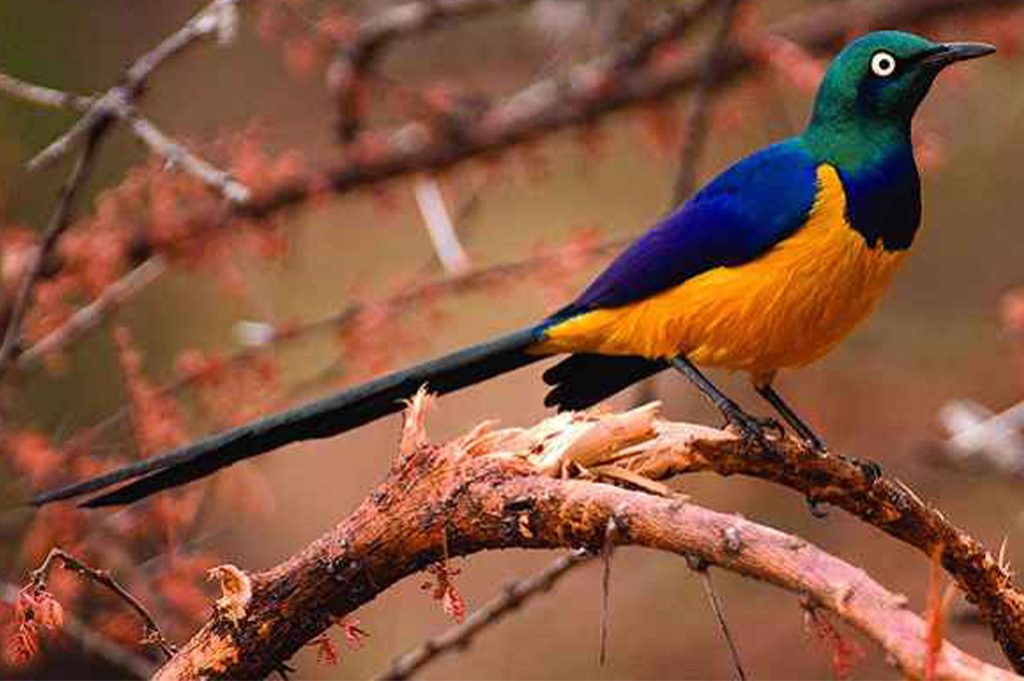DISCOVER RWANDA
Birding in Kigali City
Kigali City is Rwanda’s capital and the point of entry for flights into the country via Kigali International Airport. Kigali, one of Africa’s greenest towns, has excellent birding opportunities in Rwanda. A day or two should be given to birding in Kigali before heading out to the IBAs for birders planning a long birding itinerary in Rwanda, first as an introduction to the local species, but also because there are specialties you will notice in Kigali that you may not see again on the trip. While birders and enthusiasts on business in Kigali who have a day or half to spare and want to do some beautiful birding in Rwanda before flying out should know that Kigali is plenty to cross off a number of local species and perhaps obtain a decent number of lifers.
Kigali City boasts a lot of fantastic birding areas where you may explore a range of habitats such as wetlands, lakes/swamps, grasslands, woods, forests, and gardens. Many more wetlands in Kigali that were reclaimed for settlement, agriculture, and other purposes have been reclaimed by the government and are being transformed into protected green spaces and natural reserves that will serve as birding havens within the city. In reality, Kigali will be a birding paradise in a few years. Birding in Kigali City is made quite delightful by the city’s perfect organization and cleanliness, safety, simple accessibility of places, and nice pathways.
Where to do birding in Kigali City

Umusambi Village Nature Reserve aka Crane Village.
Umusambi Village, a new birding hotspot and possibly the best in the city, is Kigali’s first wildlife reserve, constructed specifically to rehabilitate and provide a home for rescued Grey Crowned Cranes in Rwanda. It is situated on the outskirts of Kigali City, on the road to the east of the country. The reserve, which was established on the restored marsh and includes a variety of habitats such as swamps, grassland, shrub, and forest, is home to over 100 bird species.
What makes Umusambi Wetland even more appealing for birding is a well-maintained path network that connects various portions of the reserve and provides access to various habitats. The White-collared Olive back is one of the specialties to look out for, since the reserve may have the finest sightings in Rwanda. Other birds to look out for are the Trilling Cisticola, Purple-crested Turaco, Lesser Honeyguide, Black-shouldered Nightjar, Green-winged Pytilia, African Firefinch, Olive Woodpecker, Yellow-breasted Apalis, and more.
Nyandungu Eco-Tourism Park
Nyandungu Eco-park opened in 2022, making it the newest addition to Kigali City’s birding locations. The park, which is also located on a magnificently recovered marsh, encompasses 121.7 hectares of wetland and woodland ecosystems and is home to over 100 bird species. There are 10 kilometers of paved walking and cycling routes in the ecotourism park. The stunning Black Cuckoo-shrike is one of the species to keep an eye out for.
Nyandungu is within a 30-minute drive from the city center, making it one of Kigali’s most handy ideal birding destinations. Birding in Nyandungu complements birding in Umusambi since both locations are located along a road to the east of Kigali. As a result, a half-day at Nyandungu and a half-day at Umusambi provide the best one-day birding experience in Kigali City.


Birding at Nyarutarama Lake in Kigali.
Nyarutarama Lake, located near the Kigali Golf Course, is a handy birding destination in Kigali. It has walkways around it that give great birdwatching at the lake, offering a good count of water species. Yellow-billed Duck, Squacco Heron, White-faced Whistling Duck, Hottentot Teal, Red-billed Teal, African Spoonbill, Spur-winged Geese, Little Grebe, Common Moorhen, Hadada Ibis, Black Crake, Black Egret, Cater Egret, and Black-headed Heron are among the birds you will observe here.
Many species may be found on the lake’s outskirts, including the Black Kite, African Fish Eagle, Pygmy Kingfisher, White-browed Coucal, Grey-capped Warbler, Winding Cisticola, Tawny-flanked Prinia, Paradise Flycatcher, African Hobby, Swamp Flycatcher, and more. Acacia forests to the east of the lake will add to your list of raptors like the Mountain Buzzard and various lesser species including Swifts, Martins, Swallows, and Sunbirds.
Birding at Nyabarongo Swamp in Kigali City.
The Nyabarongo Wetlands are ideal for birding. Many water birds can be seen along the edges of the Nyabarongo wetlands, including Spur-winged Geese, Great White Egrets, Cattle Egret, Little Egret, Squacco Herons, African Openbill, Yellow-billed Storks, Grey Heron, Black-headed Heron, Great Swamp Warbler, White-winged Warbler, Long-toed Lapwing, Yellow Wagtail, Common Snipe, African Marsh Harrier, and the African Jacana to mention but a few.


Birding at Mount Kigali
Mount Kigali, the largest hill in Kigali City’s vicinity, has a forest atop it that is a worthy birding spot, and some of the birds you can find there include: the African Paradise Flycatcher, White-eyed Slaty Flycatcher, Southern Black Flycatcher, Red-chested Cuckoo, Green-backed Camaroptera, Thick-billed Seedeater, Tropical Boubou, Northern Puffback, Common Bulbul, Bronze Mannikin, and the Yellow-fronted Canary among others.
Other Birding Destinations in Rwanda.
Birding in Nyungwe Forest National Park.
Nyungwe National Park is Africa’s largest and oldest Montane forest. The woodland is home to around 300 different bird species. Bigugu Mountain in the forest is one of the greatest places to see birds feeding on the tree canopies. One may also leave the forest and visit the Gisakura tea plantation, which is popular with birds. The Red-collared Babbler is undoubtedly the most popular and appealing bird in Nyungwe National Park. The Albertine owlet, Blue-headed sunbird, Grauer’s Swamp Warbler, Grauer’s Warbler, Handsome Francolin, Handsome spur fowls, Neumann’s Warbler, Purple Breasted Sunbirds, Regal sunbird, Rwenzori Batis, Rwenzori Nightjar, Rwenzori Turaco, and Red-collared babblers are among the other species found in Nyungwe forest.
The ideal method to experience this forest is to walk or bike through a segment of the Congo Nile route that runs through it, or to use one of the well-developed forest trails that go to different areas of the forest. A canopy hike is another option for exploring the environment and viewing birds. The canopy walkway in Nyungwe forest is 160 meters long and erected on top of the trees, providing a bird’s-eye view of the huge forest and its inhabitants. If you have time, you may also go to the Kamiranzovu marsh.
While birding in Nyungwe forest national park, you need to hire a birding guide to accompany you and assist you in identifying the species and forest pathways. A professional birding guide will help you identify species like the Archer’s Robin-Chat, Barred Long-tailed Cuckoo, Black-headed Waxbill, Doherty’s Bush-shrike, Eastern Mountain Greenbul, Great Blue Turaco, Grey Cuckoo-shrike, Montane Oriole, Mountain Illadopsis, Mountain Sooty Boubou, Pink-footed Puff back, Red-chested Owlet, Regal Sunbird, Ruwenzori Batis, Ruwenzori Blue-headed Sunbird, and the Sharpe’s Starling among others.
Because most birds prefer to stay in the trees, watching them in the Nyungwe forest might be challenging. Your knowledgeable birder should be able to take you to the best areas in the forest for good views of the birds. Birdwatching in the forest will also introduce you to other forest wildlife, notably primates such as Angola Colobus, Golden monkeys, and Rwandan chimpanzees.
Birding in Akagera National Park
Akagera National Park is a combination of lakes, marshes, rolling hills, and savannahs that attract 310 bird species. The park is located in the country’s northwestern corner, close to the Tanzanian border. Birding is excellent near Lake Ihema, its islands, marshes, and wetlands. A boat ride on Lake Ihema is an effective way to view birds in the park, but Rwanda birding safaris on the savannah are conducted early in the morning and late in the evening.
The morning sessions are undoubtedly the most enjoyable due to the abundance of bird activity. The Red-faced Barbet is the most abundant species in the park, but Akagera is also home to the rare papyrus Ganolex. It is also worth noting that Akagera National Park is possibly the greatest site in Africa to see the elusive Ring-necked Francolin. Expect to see Carruthers’ Cisticola, Grey-crowned Cranes, Northern Brown-throated Weaver, Papyrus Gonolek, White-collared Olive back, and White-Winged Swamp Warbler on your safari in Akagera National Park.
The African Starling is undoubtedly Akagera’s most beautiful bird. They have magnificent feathers that change color and sparkle in the middle of the day. One of the joys of a birding trip in Akagera is spotting this bird.
We should also highlight that the rare Shoebill stork lives here, but finding them takes time and patience. The dry season (May to September) is ideal for birdwatching in Akagera. The park’s southern part contains a greater diversity of butterflies and birds than the park’s northern sector. Expect to see elephants, giraffes, hippos, lions, and a plethora of antelopes when visiting Akagera National Park. Depending on your preferences and budget, you may stay in tented camps or regular cottages.
Birding in Volcanoes National Park.
This park is most known for gorilla trekking, golden monkey encounters, and mountaineering one of the mountains, such as Karisimbi. This does not affect the fact that it is one of the top birding spots in Rwanda. The park is home to around 200 different species. 27 of them can only be seen in Rwanda, while 16 are unique to the volcanoes of the Virunga mountain ranges. The Archer’s ground robin, Cinnamon bracken warbler, Grauer’s rush warbler, Rwenzori Batis, White-tailed blue-flycatcher, and Black and white manikin are among the species to watch for. Mgahinga Gorilla National Park in Uganda and Virunga National Park in Congo border the Volcanoes National Park, guaranteeing that some of the species found in these two countries may be observed in Rwanda.
Birding in Gishwati-Mukura National Park
This is Rwanda’s newest national park, located in the country’s northwest corner. Gishwati Mukura National Park was renowned as Rwanda’s birdwatching location in Rwanda’s prime site for birdwatching even before it became a national park, with 395 species on offer. The Martial Eagle, Purple-breasted Sunbirds, Red-throated Alethe, Regal Sunbirds, Ruwenzori Batis, Ruwenzori Turaco, Strange Weaver, Stripe-breasted Tit, and Grey Crowned Crane are among them.
The majority of the bird species are forest dwellers or Albertine Rift endemics. There are also people that relocate from Congo for most of the year. Expect to see baboons, chimps, blue and golden monkeys while searching for birds. You should visit Gishwati-Mukura National Park during the dry season for the finest birding experience. The wet/rainy season brings several challenges, including mud-filled paths that can be quite treacherous.
Birding at Lake Kivu.
Lake Kivu is well renowned for its picturesque beaches and islands, as well as being one of the greatest sites in Rwanda for sport fishing. It’s easy to overlook the Lake’s status as a premier birding site in its own right. White-breasted Cormorants and Pied Kingfishers flock to the lake’s natural beauty and its islets. During certain months of the year, thousands of migratory birds may be seen grazing around the lake alongside the people.
Nkora Island is a must-see for anybody interested in birdwatching in Lake Kivu. Nkora Island is a little fishing community with a diverse array of water birds and cave bats. You will also get the opportunity to interact with local fishermen and discover how they make ends meet.
When is the best time for Birding in Kigali City
In Kigali city, bird viewing is done all year. However, the best period to watch birds in their breeding plumage is from December to February. This is also the time of year when migrating birds, particularly Eurasian and Palearctic migrants, visit Rwanda’s diverse range of habitats.
The Rwandan Development Board provides skilled guides and has built a variety of birding infrastructure, including nature walking routes, campgrounds, watch towers, and canopy tours in the Nyungwe forest.


What to pack for a birding safari in Kigali?
When planning to go on a birding safari in Kigali, you will need to pack the following items; a good pair of hiking boots, a pair of binoculars, a water bottle, energy snacks, a camera and extra batteries, a portable voice recorder, a birding guide and checklist, insect repellant and sunscreen, hat/cap, long sleeved shirts and trousers among others.
Where to stay during a birding safari in Kigali City
There are quite a number of hotels where you can stay while birding in Kigali city and these include; Marriot Kigali Hotel, Serena Hotel, Radisson Blu Hotel, Four Points by Sheraton, Ubumwe Grande Hotel, Step Town Hotel, Des Milles Collines Hotel, Onomo Hotel and the Manor hotel to mention but a few.

Rules and Regulations to follow while birding in Kigali City.
Certain restrictions and norms of conduct must be followed while visiting national parks or birding sanctuaries. You must respect the birds as well as the habitat in which they dwell.
- Do not act in a way that endangers the birds’ well-being or disturbs them in any way. A competent birder should never chase birds or try to flush them out of hiding places. Allow them to come out of their own.
- Avoid using flash cameras if feasible, especially in places with a high concentration of birds and during the nesting season. Keep a safe distance from known nesting colonies to avoid disturbing the birds or exposing the chicks to harm. Do not handle eggs unless you are a researcher. Many animals leave their eggs when they are touched by humans.
- Respect the surroundings in which you find yourself. Do not leave rubbish in bird sanctuaries. Avoid trampling and leave bird habitats in the same condition you found them. While birdwatching, do not trespass on private property without first obtaining permission. You don’t want to tarnish the image of the birding community as a whole.
- Find out whether there are any unique guidelines or regulations for a particular birding location. To prevent hurting the ecosystem or alarming the birds, travel in a smaller, more controllable group if feasible.






